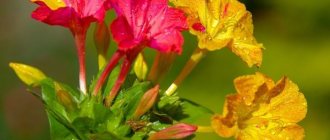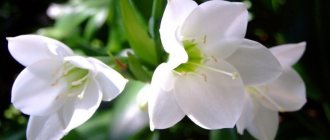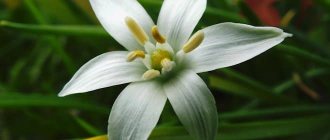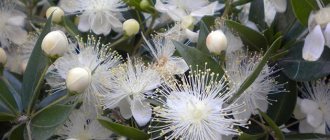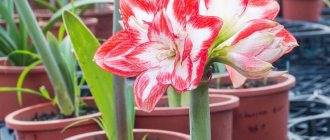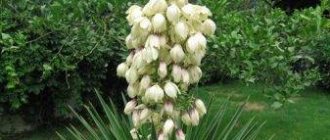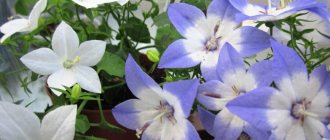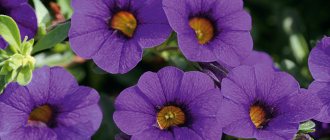Despite the fact that the bell has about four hundred and forty species, there are also some flowers that, from a distance, may be similar in structure to the bell. We have prepared for you a detailed selection of bell-like flowers with photos and basic recommendations for care and propagation. Use, save, share with other gardeners!
Adenophora
Adenophora is a close relative of the bell, which is easy to guess from its popular name - bell.
Using hedgehogs to process potatoes
Types of seedling cassettes and their use
Hazelnut - how it grows and blooms, growing a nut in the garden
This herbaceous perennial is unpretentious, can grow in both sun and partial shade, is undemanding to the type of soil, and does not require shelter for the winter. Keep in mind that adenophora needs good soil drainage and does not grow well in acidic soils.
Bellflower blooms most of the summer. Easily propagated by seeds. In this case, winter sowing is preferable. If you did not have time to sow bells in late autumn and plan to sow in the spring, it is advisable to stratify them for a month (keep them in the refrigerator).
Aquilegia
Behind the beautiful name aquilegia lies a well-known watershed. He is an eagle, doves, boots - there are countless popular names. English-speaking gardeners even call it "granny's hat."
About a hundred species of aquilegia are known, but hybrids are usually grown in gardens. Almost all watersheds feel great in the middle zone and even winter in the taiga zone without shelter. In addition, they prefer partial shade. Why isn't it an ideal plant for the garden?
The height of the plant can vary depending on the species: for example, from 30-40 cm for Biedermeier aquilegia and up to 120 cm for McCann hybrids.
Aquilegia blooms between June and August, depending on the variety. Sowing is carried out in open ground in the fall or through seedlings in March-April or in open ground in May.
Blooming annual vines
If you put climbing annuals on the fence, you will get an excellent hedge. Photos and names of the most popular climbing annual plants:
- Kobeya. From the beginning of July until the end of the summer season, large flowers bloom in white, yellow, blue, and purple shades;
- Kvamoklit has delicate greenery and bright red flowers of medium size. An excellent option for a hedge;
- Farbitis (Ipomoea). The wealth of colors covers almost the entire color spectrum. Thick leaves form a continuous shield that can protect from prying eyes. Morning glory is a poisonous plant.
The plants listed are only a small part of the opportunities that annuals provide gardeners. Depending on the characteristics of each species, annuals are grown either by seedlings or by planting seeds directly into the ground. The seeds of many annual flowers can be collected after flowering for planting the following season.
Brugmansia
This plant is often called "angel's trumpets". This is due to the fact that it grows incredibly quickly, and the flowers of this crop can increase by 3-4 cm in 24 hours, and if the growing conditions are more than favorable, then even by 6-7 cm.
Brugmansia is a large and lushly flowering tree-like shrub that reaches 5 m in height. Its flowers are incredibly attractive. These are huge bells, up to 20 cm in diameter and up to 50 cm in length.
The buds of the culture have a persistent characteristic aroma, which is especially intensified at night. The color of the petals can be pink, orange, peach, yellow, cream and even greenish.
What types of asters are there?
The following types of these flowers have become most popular among summer residents and flower growers:
Kinds
Alpine
Up to 40 cm in height. It has single inflorescences up to 20 cm in size. There are varieties with white, lilac, pink and purple flowers. This aster blooms in May-June.
Italian
The height of which reaches 60 cm. Its flowers are 3-4 cm in diameter, can be lilac, pink, lilac, lavender and blue, blooming from July to September. The most famous varieties are King George (violet-blue) and Lady Hindlip (pink).
American
New England, whose height exceeds 150 cm. These perennial asters have many inflorescences, 3-4 cm in diameter. The plant blooms in September-October.
Virginskaya
New Belgian, growing up to 150 cm. This perennial blooms in September. The most famous varieties: Ada Ballard, Mary Ballard, Dick Ballard, Herbert Wunder, Beachwood Rivel, Mount Everest, Violetta, Weiser, Elephant, Oktoberfest.
Over centuries of cultivation of this plant, breeders have developed a wide variety of varieties, significantly different from each other in the variety of inflorescences and bush height. Among them there are varieties with flat and complex double flowers. Asters of different flowering periods can be found everywhere. The early varieties delight with their splendor already in June, and the latest ones bloom in August. The latter delight with their riot of colors before the onset of autumn frosts.
Breeders have developed more than 4,000 varieties of annual asters. Their inflorescences are painted in a variety of shades: from snow white to dark purple. Flowers are small (3 cm) and large (up to 20 cm). Their height can vary from 20 to 100 cm.
By height
Experts distinguish groups (varieties) differentiated according to various characteristics, which include the height and shape of the bush, the type and shape of the inflorescence. In total there are up to 40 varieties. The most common are approximately 200 varietal asters, which are representatives of only 20 varieties.
Divided into certain groups based on the selected characteristic, all varietal asters according to the size of the bush are divided into: tall/medium-sized/short, reaching heights respectively: up to 100 cm/up to 60 cm/up to 35 cm.
According to the structure of asters and the shape of inflorescences
Reed
Pseudo-ligulate flowers add decorativeness. Short tubular flowers are completely closed or visible at the final stage of flowering. Reed flowers can have different shapes and sizes. Reed varieties of asters are very similar to the flowers of peonies and chrysanthemums. These include the overwhelming number of aster varieties. These asters have 6 types: curly, needle-shaped, imbricated, radial, hemispherical, spherical.
Tubular
Tubular flowers add decorativeness. Their inflorescences are densely double or flat-round. Such varieties are most often found among breeders and collectors of these plants. This type of asters includes 3 variety series: Tubular, Cirrus, Lilliput.
Transitional
Tubular and reed flowers are equally decorative. Such asters are still not very common. They are divided into 3 types: simple, coronal, semi-double. Today there are 6 variety series of this type of asters: Margarita, Sonnenkugel, Sonnenschein, Edelweiss, Valderese, Apollo.
Coronet
Having double inflorescences consisting of elongated tubular flowers. They have several rows of reed flowers, which are longer than the tubular ones. They include 7 variety series: Pompom, Fantasia, Ambria, Princess, Laplata, Aurora, Ambria.
Semi-double
Along the edge of the inflorescences there are more than 2 rows of reed flowers. There are 6 variety series: Madeline, Anmut, Anemone, Mignon, Victoria Baum, Rosette.
By way of using colors
Casing
Which are characterized by compact bushes, long and abundant flowering. They have a small height, so they are most often used to create mixborders, growing in containers or pots. Their inflorescences are not too large.
Universal
Combining small size and stability of peduncles. Such asters can be used both for growing in the garden and for cutting.
Hyacinthoides
Hyacinthoides are bulbous perennials that belong to the early flowering plants. There are other names: “Spanish scilla”, “Spanish endymion”, “Spanish scilla” and “wild hyacinth”.
This is an unpretentious crop that can often be found in flower beds and garden plots. The plant has basal leaves 20-30 cm long and a single peduncle reaching a height of up to 30 cm.
Hyacinth may have lilac, white, pink, blue or blue bell-shaped flowers 1.5-2 cm in diameter. The crop blooms at the end of May or beginning of June, and this period lasts up to 20 days.
Traditional annual flowers that bloom all summer, with photo and name
There are flowering annuals that are traditionally used to decorate city parks and squares, country houses and summer cottages. They are known to everyone since childhood. Such flowers are simple and unpretentious, but without them it is difficult to imagine at least one landscape solution.
Below is a brief description of traditional annual flowers for the garden that bloom all summer, with photos and names.
Marigold
Annual flowers Marigolds
Very cute and bright. Large varietal range with different bush heights, size and color of flowers. The colors of the buds are always warm: from pale yellow to red-brown. They come in simple and terry shapes. The bushes are densely branched, compact and stable. For borders, varieties that grow up to 20 cm are used, and for flower beds - up to 60 cm. Marigolds are hardy, cold-resistant, easily tolerate drought and poor soil, but do not like shade and dampness. It is better to grow through seedlings, then flowering begins at the end of May. They emit a not very pleasant smell, but this feature of the flower repels pests, including white butterflies, cutworms, weevils, Colorado potato beetles, etc.
Calendula
Annual flowers Calendula
In common parlance - marigolds. The stem is erect, fragile, up to 50 cm tall, with ovate leaves and many inflorescences - baskets. Flowers with orange and yellow petals of simple shape. It blooms from early June until the snow, and easily tolerates five-degree frosts. Loves bright sun. It is the most valuable medicinal raw material.
Petunia
Annual flowers Petunia
Low-growing (up to 30 cm) or tall (up to 70 cm) annual plant with a shallow root system, densely branched stems, which can be either creeping or erect, depending on the variety. For the same reason, the leaves vary in shape and shades of green. They have a faint edge. The flowers are solitary, funnel-shaped, with an upper extension and a surprisingly varied color and structure of the petals. The plant is thermophilic, prefers well-lit flower beds, blooms constantly, and is grown as seedlings.
Snapdragon
Annual flowers Snapdragon
In common parlance - dogs. It is harmonious in any landscape combination, often used as a border planting, and hanging varieties are ideal for flowerpots. Perennial, but in the Russian climate it can only live for one season. The seeds are well stored. Seedlings (sown in February-March) develop slowly at first; after the 5th leaf appears, the main shoot is pinched so that the plant bushes. Planted in a flowerbed at the end of May in a sunny and dry place. Blooms all season until October, unpretentious. It grows up to 45 cm, has original two-lipped flowers of various colors.
Viola or Pansy
Annual flowers Pansy
Common garden annuals. Nowadays, monocolor varieties are especially popular, which are great for contrasting solutions. Low-growing, reaching a maximum height of 25 cm. The flowers are single (up to 10 cm in diameter) with a wide range of colors; some varieties have a subtle, pleasant aroma. Seeds are planted directly into the ground at the end of May. For early flowering, you can sow seedlings in March. They can easily tolerate a little shade. The soil should be fertile, watered regularly, but without stagnation of moisture. Loves fertilizers, especially with phosphorus to improve flowering.
Climbing annual flowers for the garden
There is a special type of annuals that are a salvation when decorating garden buildings, be it fences, walls of buildings or gazebos, arches and hedges. We are talking about climbing annual flowers for the garden. The use of this group of annuals in landscape design is mandatory and justified.
Lianas will protect an area located next to a busy highway from dust and noise, decorate an unsightly façade, and serve as a screen or hedge. When choosing a loach variety, you should think about what kind of support it should have. There are quite heavy, densely growing vines that will require an impressive supporting structure.
It is necessary to think in advance about the place where the climbing plant will grow:
- the south and southeast are perfect for ampelous gloxinia, sweet peas, cornflower and morning glory;
- the eastern part of the site is ideal for kobei and dolichos;
- the shaded northern and northwestern sides are for ivy and maiden vine.
Gentian
Gentian has not yet taken root among our gardeners as a popular flowerbed decoration. It is quite rare to find it in a modern front garden. However, this plant is undeservedly underrated. This is a low to medium-height herbaceous plant with large flowers located very close to each other, thus creating a blooming cloud. The gentian plant came to us from the wild. It is great for decorating flower beds, edging flower arrangements, and also for decorating borders. This flower has collected the widest palette of blue shades. No other plant can boast such an abundance of blue, blue and purple flowers. There are about 90 varieties of gentian, among which there are other shades, for example, white, pink and yellow. Gentian has a long flowering period, which begins in summer and ends in late autumn. It is quite common in different latitudes of Europe and Asia.
How to water Decembrist at home?
How to replant aloe at home step by step
How to replant anthurium at home video
A plant such as gentian is propagated by dividing the bush, cuttings or sowing seeds. Planting and caring for seedlings require attention. Growing gentian from seeds is difficult because the seeds are very small and their development requires moist, well-ventilated conditions with a temperature of 7 degrees Celsius. They germinate only after 1-3 months. If the temperature rises significantly during this period, the seedlings may die.
Campanula flower. Description, features, types and care of campanula
Description and features of the campanula
Campanula is a numerous genus of herbaceous plants, uniting more than 400 species. Literally, “campanula” is translated from Latin as “bell.” The origin of the name becomes obvious, once you look at the photo of the campanula - the shape of the flowers speaks for itself.
The homeland of this delicate flower, so beloved by gardeners and fans of indoor plants, is the Mediterranean region. In the wild, these plants can be found in Western and Central Asia, in Siberia, in the Caucasus Mountains, in some European countries, as well as in North America.
Campanula grows well both in steppe and wooded zones, and is found in desert rocky areas and in alpine meadows.
Campanula is a creeping ampelous plant with small (maximum 50 cm) shoots on which light green neat leaves are located. The shape of the foliage depends on the type of bell; plants with carved leaf edges are often found.
The Campanula flower is cup- or bell-shaped and ranges in color from snow-white to deep purple. Inflorescences, like leaves, depend on the variety: racemes, paniculate and solitary flowers are found.
Planting and propagation of Campanula
At home, Campanula propagates by seeds, cuttings and dividing the bush. The first method is the most time-consuming, but the most fun.
It is interesting to watch how the seedlings appear, how quickly they grow, and how the first long-awaited buds of the blooming campanula then appear. The seeds of the house bell are very small - there are about 5000 pieces in 1 gram.
They are sown in spring in nutritious soil and lightly sprinkled with earth. It is not recommended to water the crops; moisten the soil with a spray bottle so as not to wash away the small seeds.
It is much easier to propagate Campanula from cuttings. It is advisable to choose shoots closer to the base of the shoot; they produce roots better and faster, and their survival rate is an order of magnitude higher. The top with the buds is pinched off.
It is better to immediately plant a freshly cut cutting in a special substrate made of sand and peat, since rooting in water threatens to rot. To moisten the soil, as in the case of seeds, spraying is sufficient.
Dividing the bush is a simple and reliable way to propagate home campanula . In the spring, when the plants gain strength and begin to grow actively, the adult bush is carefully removed from the pot and the earthen lump entangled in small roots is literally cut.
Each such piece is placed in a separate container so that there is no more than 1-1.5 cm of free space for root growth. In this case, the soil around the edges will not sour and planting the campanula in a new pot will be less stressful for the plant.
There is another way to root indoor campanula . It is used less often than others by lovers of indoor plants, but with this method, the propagation of bells is quite successful.
A woody fragment is taken at the base of the stem, which has several internodes with already fallen leaves. It is laid parallel to the ground and lightly covered with soil. The container is placed in greenhouse conditions, and soon a young plant begins to develop from each internode.
Wide, but not too tall pots are suitable for growing. The bell is absolutely unpretentious in the composition of the soil; a universal one, which is sold in any flower shop or hypermarket (Obi, Auchan, Leroy Merlin), is quite suitable.
Campanula care
Maintaining a campanula in an apartment or other premises is not much of a hassle. The main criteria for good growth and development are regular watering and good lighting. This is why this flower is so popular.
It will decorate any home; very often it is grown as an hanging plant and placed in beautiful flowerpots. Lush shoots with small succulent leaves, dotted with cup-shaped flowers cannot but arouse admiration even among people far from plant growing.
Campanula, the care of which, as it turned out, is quite simple, still has its own preferences, ignoring which, the gardener may have problems with its cultivation.
This plant loves abundant and frequent watering, so in hot summer the bush needs to be watered little by little, but 2 times a day in the morning and evening, and also sprayed periodically.
This type of bell does not tolerate rearranging or turning the pot. Any such manipulations have a detrimental effect on the appearance and well-being of the green pet.
To make the plant more lush and decorative, in the spring and early autumn almost all the growth is cut off from it, leaving short cuttings no more than 12 cm long. Some will think that this can harm the plant, but no, on the contrary, it stimulates it to develop new ones strong branches with strong peduncles.
Campanula bell is a light-loving and at the same time very delicate plant. Direct sunlight has a detrimental effect on both lush greenery and flowers. If the pot or flowerpot is located on the south side, it is necessary to shade the bell if possible.
The lack of light also affects the health of the campanula: cuttings and branches are pulled out, the leaves become thinner and smaller, and the attractive decorative appearance is lost.
Like any other representatives of home flora, campanula needs regular fertilization. For these purposes, an ordinary universal remedy is suitable; you don’t have to choose a special composition, like orchids or succulents.
Types of campanula flower
Among such a variety of bell species, only a few are grown at home. Among them, the most common are:
- equifolia;
- terry;
- Carpathian;
- Blauranka.
Since ancient times, the campanula flower has been considered a wedding flower. It was given to newlyweds as a symbol of a happy and long life together, full of love and prosperity.
Even in the Soviet period, even-leaved campanula was called “bride and groom”; most flower growers did not know its scientific name. This type of campanula is a perennial herb no more than 30-35 cm high.
The leaves are round in shape with a slightly carved edge and long stalks. The foliage color is rich green. During the warm season, the entire bush is covered with numerous bell flowers.
Campanula "groom" (Maya) is distinguished by the lilac-blue color of its cute bells. Campanula “bride” (Alba) - painted in its inherent color of innocence and purity - white.
Many people plant these two plants in one container, then in the spring the “bride and groom” campanula delights its owner with a variety of colors in white and lilac tones. This union looks very impressive.
Knowledgeable people divide the container of the pot into several parts, because they believe that the “bride” is more tenacious and over time can displace the “groom”, filling the entire pot.
Terry campanula is a hybrid variety obtained from the Carpathian and spoon-leafed bellflowers. The bush is distinguished by beautiful flexible branches with jagged leaves that densely cover the entire plant.
The flowers resemble small roses in shape, painted in different shades of white and purple. Many people note that terry campanula is somewhat more capricious than its equal-leaved relative; it is quite difficult to obtain abundant and long-lasting flowering from it.
Carpathian Campanula is characterized by egg-shaped leaves grouped into a rosette near the roots. This perennial is quite compact and unpretentious, it does not grow more than 30 cm in height. This type of campanula is a garden one , it is often used in landscape design when decorating flower beds and alpine slides.
Campanula Blauranka differs from its fellow bellflowers in the larger size of its flowers and leaves, but can only reach 20-25 cm in height. This variety is suitable for both growing in apartments and in garden plots.
Buying campanula, if desired, will not be difficult. These delicate, romantic plants are sold both in flower shops and on the Internet. The price of a young specimen is approximately 350-400 rubles. There are also seeds on sale; one bag will cost about 100 rubles.
Nowadays, the popularity of this plant is gaining momentum, many people like the decorative qualities of the flower, many remember childhood, when every self-respecting housewife, along with porcelain elephants and lace napkins, had two inseparable pots with white and lilac flowers on her windowsill.
Datura
Datura common (photo below) is difficult to confuse with other plants. He is big, even huge. The bush can grow up to a meter in height. The leaves are beautifully cut. They look powerful, fresh, attractive (for those who eat grass). Only animals will not feast on them. They are repelled by a strange, even disgusting smell. Datura plant can be found in large quantities in any area. Typically, Datura chooses the following areas for its habitat: wastelands, roadsides and vegetable gardens. Datura grass flowers are so magnificent that this plant has attracted the attention of landscape designers. It can be seen in flower beds and lawns. The plant is used as an ornamental. Moreover, it has a fairly long flowering period: almost all summer (depending on climatic conditions) it delights viewers with huge bowls of white flowers. You just need to keep in mind that the plant is poisonous. Flowers can be intoxicating (hence the name) with just their scent. In hot weather, in the absence of wind, it concentrates around the plant. It is not advisable to plant such “decor” in the area near children’s playgrounds, institutions, cafes, and so on. Kids may not realize that they should run away from a cloying aroma. The result is a hospital.
Pests and diseases
With excessive watering, the plant is often affected by fungus. Dry air can encourage pest attacks. Scale insects or spider mites will very quickly show up on cute bushes without proper care. The plant must be inspected in the heat, and if pests are found, insecticides should be used. To be sure, carry out 2-3 procedures of spraying the plant.
Spider mite
Shchitovka
If the leaf blades of a plant suddenly turn yellow or pale, it is recommended to change its location. Such symptoms occur when the lighting is too bright. If the stems become thin and overly elongated, it can be judged that there is a lack of light. If foliage loses turgor, it is recommended to establish a normal watering regime. Overmoistening or overdrying of the soil is observed.
If the plant is affected by gray rot, you can try to save the bush with the help of a fungicide.
Lobelia
From June to September, lobelia pleases us with its flowering. Planting and care are not difficult. Photos taken in summer cottage gardens show that this delicate flower will look appropriate wherever you plant it. Lobelia flower fireworks have a different range of shades: white, red, burgundy, purple, blue, light blue. It is used to design flower beds, garden paths, borders, mixborders, flower “streams” or rugs.
Lobelia belongs to the bellflower family and is a creeping plant. The bushes are distinguished by abundant flowering, since small fan-shaped flowers bloom almost simultaneously, their number is huge.
The most common varieties of lobelia begin to bloom approximately 70-80 days after sowing the seeds. If you want to time the appearance of flowers just in time for the beginning of summer, then you need to start sowing seedlings in March. In general, these dates are not critical; they can be slightly shifted either towards February or closer to April. If sowing will be done at the end of February, then you will not be able to do without the help of lighting (fluorescent, halogen, LED lamps). Germination of lobelia sprouts can be observed already on the tenth or twelfth day after sowing.
Bluebells amaze with their large number of varieties with which you can decorate your garden. And at the same time, it requires absolutely no complicated care.
Planting and care
Despite its fragility and tenderness, this plant as a whole can be called unpretentious. Having learned the basic requirements of campanula for growing, it can be enjoyed by an amateur and an experienced gardener.
Where to plant
This plant is light-loving, so it should be placed in sunny areas of the garden with light shade. At midday, direct rays of the sun will harm foliage and delicate flowers. If the plant is grown in a pot, then in hot weather it is better to put it in a shaded place.
If Campanula is planted indoors, it is recommended to place it on windows of east or west orientation. If the plant is deprived of the proper amount of light, it will become pale and frail. If necessary, in room conditions, additional illumination from artificial light sources will be provided.
If the recommended lighting conditions are met, then you can place the pot with campanula on the balcony for the entire summer season. At the end of September, when the nights become cooler, the flower is returned to its original place indoors.
This plant has problems with temperature fluctuations. In summer, campanula feels great at temperatures of +20....+25C, and in winter it can grow normally at temperatures of +15C. During winter maintenance, the flower container with the plant should be removed away from heating devices, which are a source of dry air.
Although it is worth recognizing that air humidity is not particularly important for this plant. If the air in the room is excessively dry, it is recommended to spray the bush.
Watering
Campanula should be watered as the soil dries. This wonderful representative of the flora is suitable for those owners who are away for several days and cannot water their plants. There is evidence that campanula can live for several weeks without moisture. But loving gardeners will not unnecessarily subject their plants to such tests.
In hot weather, the soil in the container dries out very quickly, so it is necessary to water the plant much more often. Water is used that is warm and preferably settled. Tap water is not suitable for irrigation.
The soil
The soil for campanula requires loose, nutritious soil. The plant must be nourished by microelements contained in the soil. An excellent soil option is a mixture of peat and leaf soil. Feed the bushes twice every 30 days. Universal mineral compositions are suitable for these purposes. In winter, when the plant is dormant, it does not need fertilizer.
Planting and transplanting
Not all types of Campanula are perennial, so annual replanting is not always necessary.
It often happens that a plant grows excessively in one container or in a garden bed. And then it makes sense to transplant the campanula.
When transplanting a flower into a container, a drainage layer is poured onto the bottom, after which it is covered with nutritious soil. The plant is placed in a hole and covered with soil mixture. After soil compaction, watering is carried out. If in the autumn a bush is transplanted from a garden bed into a flower pot to move the plant into a room, then they try to remove the root system with a lump of earth.

